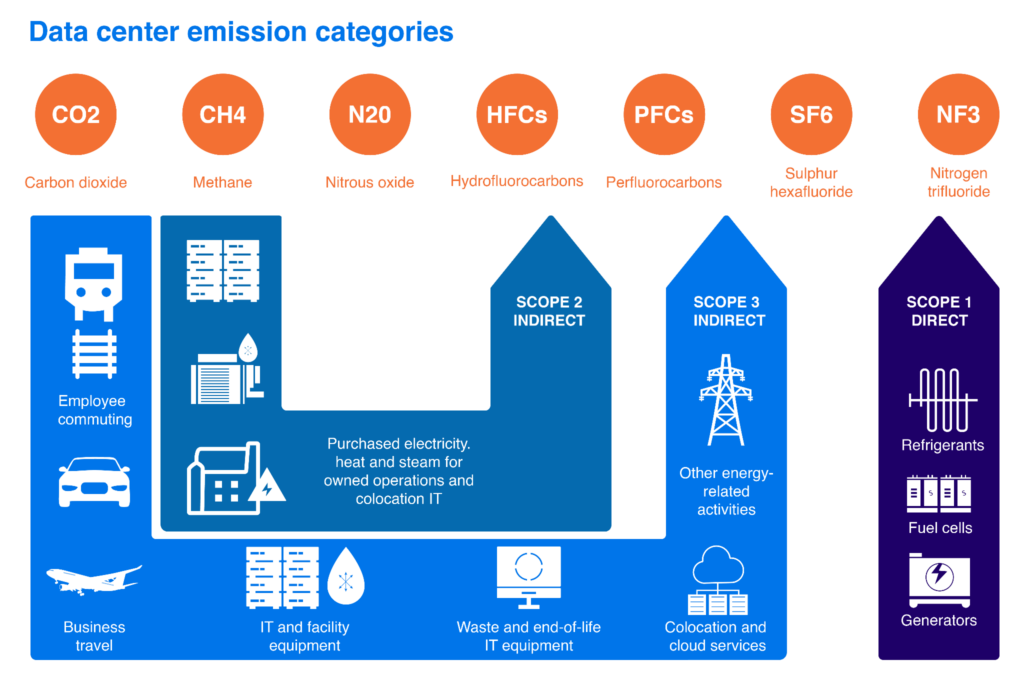Data Center Carbon Footprint: Concepts and Metrics
A data center’s carbon footprint refers to its total amount of greenhouse gas emissions and is typically measured in carbon dioxide equivalent (CO2e). It includes emissions from energy consumption, cooling, infrastructure, and other activities associated with data center operation. The carbon footprint quantifies the environmental impact of the data center on climate change.
Addressing carbon emissions in data centers is crucial due to their significant levels of energy consumption. Data centers play a key role in modern technology and business operations, but their energy-intensive nature can lead to substantial carbon emissions. By focusing on carbon reduction, data centers can do all of the following:
- Contribute to global climate goals
- Reduce environmental impact
- Enhance sustainability
- Meet regulatory requirements
- Improve operational efficiency
- Demonstrate corporate responsibility
Summary of key data center carbon footprint metrics and terms
Mitigating carbon emissions in data centers aligns with broader efforts to combat climate change and transition to a more sustainable energy future. The metrics and terms in the table below provide insights into various aspects of data center carbon emissions measurements.
| Metric | Description |
|---|---|
| Carbon dioxide equivalent (CO2e) | A measure that converts the various greenhouse gasses emitted (such as CO2, CH4, N2O, etc.) into the equivalent amount of CO2, simplifying comparisons of their global warming potential. It provides a standard unit to express the overall impact of different gasses on climate change. |
| Power usage effectiveness (PUE) | A metric that quantifies the power efficiency of a data center by dividing the total power consumption of the facility by the energy consumed solely by IT equipment. Lower PUE values indicate better energy efficiency. |
| Carbon intensity | The amount of carbon emissions produced per unit of energy generated or consumed. It helps assess the environmental impact of energy sources and is often used to compare the sustainability of different energy options. |
| Carbon footprint | The total amount of greenhouse gas emissions (expressed in CO2e) directly or indirectly produced by an individual, organization, product, or activity. It is a comprehensive measure of an entity’s impact on climate change. |
| Carbon usage effectiveness (CUE) | A metric similar to PUE but focused on carbon emission effectiveness. CUE measures the carbon emissions (CO2e) produced per unit of IT work performed in a data center, including both IT equipment and supporting infrastructure. |
| Water usage effectiveness (WUE) | Similar to PUE, WUE is a metric used in data centers to assess the effectiveness of water usage. It compares the total water consumption of the facility to the water consumed by IT equipment, indicating water efficiency. |
| Energy reuse effectiveness (ERE) | ERE is a metric that evaluates the efficiency of energy reuse within a data center. It calculates the ratio of total energy used to the energy recycled or repurposed within the facility. Higher ERE values indicate better energy reuse practices. |
| Carbon offsetting | Offsetting is the practice of compensating for carbon emissions by investing in activities or projects that reduce or remove an equivalent amount of greenhouse gasses from the atmosphere, such as tree planting or renewable energy projects. |
| Energy efficiency ratio (EER) | Similar to PUE, EER measures the energy efficiency of cooling systems in buildings or facilities. It calculates the cooling output (in BTUs) divided by the energy input (in watts) of the cooling system. Lower EER values indicate better cooling efficiency. |
Understanding the data center carbon footprint and emission types
Data centers are critical infrastructure powering the digital age by housing servers, storage systems, and networking equipment that enable online services, applications, and communication. They play a pivotal role in supporting cloud computing, ecommerce, social media, the internet of things (IoT), and much more. However, they also exhibit high energy demands and create substantial carbon emissions due to their extensive operations.
The carbon footprint of a data center is the sum of CO2e emissions produced during its operations. This includes both direct and indirect emissions.
Direct emissions
Direct emissions from data centers, also known as scope 1 emissions, arise from activities that occur within the boundaries of the data center itself that are under its direct control. Direct emissions include the following:
- Fuel combustion: Emissions produced from burning fossil fuels on-site, such as natural gas for backup generators or heating.
- Chemical reactions: Emissions from chemical reactions within the facility, such as refrigerants used in cooling systems.
- On-site processes: Emissions from specific processes or activities conducted within the data center, like waste incineration.
Indirect emissions
Indirect emissions, also categorized as scope 2 and scope 3 emissions, are associated with activities outside the direct control of the data center but are linked to its operations. Indirect emissions include the following:
- Electricity consumption: The largest source of indirect emissions for data centers is usually the electricity used to power IT equipment, cooling systems, lighting, and other operations. These emissions occur at the power plants generating the electricity and are considered scope 2 emissions.
- Supply chain: These are emissions associated with the manufacturing, transportation, and disposal of equipment used in the data center, such as servers, networking gear, and cooling infrastructure.
- Employee commuting and travel: This encompasses emissions resulting from the travel of employees to and from the data center as well as any business travel related to the data center’s operations.
Comparing direct and indirect emissions
It’s important to note that while direct emissions are relatively more straightforward to measure and control, indirect emissions—particularly from electricity consumption—can make up a significant portion of a data center’s carbon footprint. Accordingly, data centers often focus on improving energy efficiency, transitioning to renewable energy sources, and considering the broader lifecycle impact of their operations to effectively manage both direct and indirect emissions.

Data center emission categories (Source)
Impacts of data center carbon emissions
Data center carbon emissions can have wide-ranging impacts on the environment, economy, and society. Here are some of the most important considerations:
- Climate change: The accumulated greenhouse gasses from emissions (including those from data centers) intensify climate change, causing rising temperatures, more frequent and severe weather events, sea-level rise, and shifts in ecosystems. These changes have far-reaching impacts on habitats, wildlife, agriculture, and coastal communities.
- Resource depletion: Data centers rely on energy-intensive processes and equipment, contributing to resource depletion. The extraction and processing of minerals, metals, and fossil fuels for energy and equipment manufacturing can strain natural resources and ecosystems.
- Public health concerns: Data center carbon emissions and related air pollutants can degrade air quality and contribute to respiratory issues, allergies, and other health problems in nearby communities, posing risks to public health.
- Rising energy costs: High energy consumption by data centers can strain local power grids, potentially leading to energy shortages and increased energy costs for consumers and businesses. This can impact the overall economic stability of society.
Calculating carbon footprint
The calculation of a data center’s carbon footprint involves quantifying the emissions associated with its energy consumption, often using emission factors provided by energy sources. The formula to calculate the data center carbon footprint is:
Carbon footprint = Energy consumption × Emission factor
Where:
- Energy consumption (kWh): The total energy consumed by the data center over a specific period.
- Emission factor (kg CO2e / kWh): The factor that represents the amount of CO2e emissions produced per kilowatt-hour of energy generated based on the energy sources procured when on the grid (e.g., coal, natural gas, or renewable sources).
The resulting value represents the total amount of CO2e emissions attributed to the data center’s energy usage. This calculation provides insights into the environmental impact of the data center and helps stakeholders understand and manage its carbon emissions.
Why calculating the data center carbon footprint is important
Calculating the carbon footprint of a data center is a critical step to quantifying the impact of its operation. To understand how substantial this can be, let’s consider an example using the calculation from the preceding section.
Suppose we have a large data center consuming 100,000 MWh per year of electricity with an emission factor of 0.5 kg CO2e/kWh. Multiplying these figures results in an annual carbon footprint of 50,000,000 kg CO2e. This is equivalent to the emissions of over 10,000 cars or the carbon sequestration of around 600,000 trees in a year, underscoring the substantial environmental impact of data centers.
Carbon footprint calculation can help data center operators do all of the following:
- Identify areas for emission reduction and take meaningful steps to mitigate the impact of the data center’s emissions on the climate.
- Obtain a tangible measure of greenhouse gas emissions that can be tracked over time.
- Set realistic reduction targets that align with organizational climate goals and international agreements, such as the Paris Agreement.
- Make smart choices related to transportation, energy sources, supply chain management, product design, and more.
- Enable transparent disclosure of an organization’s environmental impact, which drives informed decision-making and demonstrates commitment to emissions reduction, fostering credibility and stakeholder trust.
Current efforts to reduce data center carbon footprints
Data center companies are actively implementing various strategies to reduce their carbon footprints and promote environmental sustainability. Some of the current efforts include the following:
- Renewable energy procurement: Many data centers are sourcing a significant portion of their energy—or even 100% of it—from renewable sources such as solar, wind, and hydroelectric power.
- On-site microgrids: These are localized energy systems that operate independently or in conjunction with the main power grid. They integrate various energy sources—such as solar panels, wind turbines, batteries, and sometimes backup generators—to provide partial or full electricity supply to the data center. On-site microgrids can operate autonomously, disconnecting from the main grid during outages or interacting with the grid to manage energy supply and demand.
- Energy-efficient infrastructure: Implementing energy-efficient hardware, such as servers and cooling systems, helps minimize energy consumption and optimize performance.
- Data center consolidation: Merging multiple data centers into a smaller number of larger facilities helps reduce energy consumption and overall carbon emissions.
- Virtualization and cloud services: Virtualization technologies and cloud computing enable higher server utilization and better resource sharing, leading to energy savings and reduced physical infrastructure.
- AI and machine learning: These technologies can optimize data center operations, predicting and managing energy consumption, cooling, and workloads more efficiently.
- Lifecycle management: Proper disposal and recycling of IT equipment at the end of its life cycle reduces waste and environmental impact.
- Use of monitoring and optimization Tools: Data center infrastructure management (DCIM) tools help monitor and optimize resource usage, leading to better energy efficiency and reduced waste.
Industry standards and certifications
The table below describes some prominent standards in the field that play a vital role in guiding data center practices toward greater sustainability and reduced carbon emissions.
| EPA Energy Star for Data Centers | A certification program by the US Environmental Protection Agency (EPA) that promotes energy efficiency and environmental responsibility in data center operations. |
| The Green Grid PUE Measurement | Describes the PUE metric developed by The Green Grid to measure data center energy efficiency by assessing how much energy is used for computing versus supporting infrastructure, guiding efforts to minimize energy waste. |
| ISO 14001:2015 Environmental Management System | An international standard that provides a systematic framework for organizations to manage and improve their environmental performance, addressing aspects such as energy use, emissions, waste, and resource efficiency. |
| U.S. Department of Energy (DOE) Better Buildings Challenge | A voluntary initiative that encourages organizations to commit to reducing energy consumption by 20% within a decade, facilitating energy-efficient practices and carbon emissions reduction. |
| LEED for Data Centers | This is the Leadership in Energy and Environmental Design (LEED) certification adapted for data centers, recognizing facilities that prioritize energy efficiency, sustainable site development, water savings, and resource stewardship. |
| EN 50600-2 – European Standard for data centers | This European standard provides guidelines for designing and operating energy-efficient data centers. It focuses on the physical infrastructure, layout, and energy consumption aspects of data centers. It also outlines recommendations for optimizing energy efficiency, enhancing cooling systems, and ensuring sustainable resource usage. |
Challenges and limitations
Measuring data center carbon footprints is a valuable endeavor, but it comes with a number of challenges. Addressing these issues and limitations requires collaborative efforts among industry stakeholders, governments, and organizations to develop standardized methodologies, provide financial incentives, raise awareness, and establish supportive policies. Overcoming these barriers can lead to more accurate carbon footprint assessments and effective emissions reduction strategies in the data center sector.
Some of the barriers and concerns here include the following:
- Technical barriers: Complexities in accurately measuring and calculating data center carbon footprints can arise from intricacies related to energy consumption, emissions, and data collection. These challenges may involve varying equipment efficiency levels, dynamic workloads, and diverse energy sources, leading to difficulties in obtaining precise carbon footprint figures.
- Economic constraints: Investing in energy-efficient technologies and renewable energy sources requires upfront financial commitments. Data center operators might face economic constraints that hinder their ability to adopt these solutions—especially smaller or financially strained organizations.
- Lack of awareness and prioritization: A lack of awareness about the environmental impact of data centers and their carbon footprints can lead to insufficient prioritization of emission reduction efforts. Organizations might not fully recognize the importance of addressing data center carbon footprints within broader sustainability goals.
- Regulatory and policy gaps: Inconsistent or inadequate regulatory frameworks and policies related to data center emissions can create uncertainty and ambiguity. A lack of clear guidelines may deter data center operators from proactively addressing their carbon footprints.
Case studies and success stories
Several companies have taken significant strides in leading carbon reduction efforts. A few notable examples include these:
- Google has been a pioneer in sustainability, committing to operating carbon-free by 2030. The company has matched all of its energy consumption with renewable energy sources and invests in large-scale renewable energy projects.
- Salesforce achieved net-zero greenhouse gas emissions and 100% renewable energy for its global operations. The company focuses on sustainability in data centers, energy-efficient buildings, and low-carbon transportation.
- Microsoft has set ambitious goals to become carbon-negative by 2030, removing more carbon from the environment than it emits. The company invests in carbon removal technologies and has committed to using 100% renewable energy by 2025.
These companies serve as inspirations for others, showcasing that sustainable practices, renewable energy adoption, and carbon reduction are not only environmentally responsible but also economically viable strategies.
Here are some specific examples of innovative solutions and best practices adopted by organizations worldwide:
- Liquid cooling and immersion at Microsoft: Microsoft is exploring submerged liquid cooling technology to enhance energy efficiency in its data centers.
- Edge computing at Amazon: Amazon’s deployment of edge computing minimizes data transmission distances, reducing energy consumption and latency.
- Renewable energy at Google: Google’s extensive investment in renewable energy projects, including wind and solar farms, powers its data centers with clean energy.
- AI-driven efficiency at IBM: IBM uses artificial intelligence to optimize data center operations, leading to energy savings and improved performance.
- Data center heat reuse at Fortum: Finnish energy company Fortum captures and reuses waste heat from data centers to warm homes and buildings in Helsinki.
Finally, here are some noteworthy policy interventions and incentives:
- EU Green Deal: The European Union’s Green Deal aims to make Europe the world’s first climate-neutral continent by 2050, setting policies to drive data center energy efficiency and sustainability.
- Renewable energy tax credits (US): In the United States, tax incentives and credits encourage companies to invest in renewable energy sources for data centers.
- Carbon pricing initiatives: Carbon pricing mechanisms, such as carbon taxes or cap-and-trade systems, create financial incentives for businesses to reduce their carbon emissions.
- Government procurement of renewable energy: Governments and public institutions procuring energy from renewable sources can stimulate market demand for clean energy solutions.
- Voluntary agreements: Voluntary agreements between governments and data center operators, like the Dutch Datacenter Association’s Green Deal, promote energy efficiency and carbon reduction.
Conclusion
The time for action is now. To address high data center carbon footprints, it’s imperative that organizations, governments, and individuals come together to:
- Invest in renewable energy sources and energy-efficient technologies.
- Adopt best practices like liquid cooling, waste heat reuse, and circular economy principles.
- Advocate for and support policy interventions that incentivize emissions reduction.
- Embrace sustainable data center designs, operations, and reporting.
In this article, we delved into the critical issue of data center carbon footprints, shedding light on the environmental impact of data centers and exploring strategies to address the associated challenges. We examined key metrics, industry standards, and the significance of calculating carbon footprints. We also highlighted the far-reaching consequences of data center emissions and offered insights into the efforts of industry leaders and innovative solutions.




